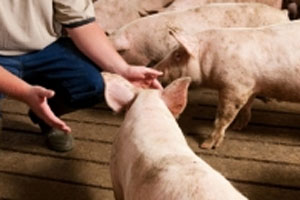Canadian pig industry and Governments tackle challenges

Over the past several months, federal, provincial and territorial governments have been working closely with the Canadian Pork Council, producers, processors and others to carefully assess the challenges facing the hog sector in Canada.
High feed costs coupled with low hog prices have resulted in increased pressure for hog producers in recent months.
Governments recognize the pork industry as an important driver of our economy. The Canadian pork industry generated close to four billion dollars in farm cash receipts in 2011; Canadian producers exported $3.6 billion worth of live hogs and pork.
“Supporting the industry’s long-term viability benefits all Canadians,” said federal Agriculture Minister Gerry Ritz. “That’s why, after meeting with industry leaders earlier this summer, we formed a government-industry task team to examine the state of the sector more closely and to monitor the industry going forward.”
The Hog Industry Task Team, which includes leadership from the Canadian Pork Council (CPC) and the Canadian Meat Council, pork processors and producers, was formed to develop a common understanding of the challenges facing the sector and to look at possible solutions to address them, including working to ensure the sector makes full use of existing programs. Provinces and financial institutions have also been engaged in these ongoing discussions. There is broad consensus among industry and market analysts, both in Canada and abroad, that market conditions for hog producers will improve by the spring of 2013.
“Alberta hog producers are going through a difficult period. Fortunately, there are a number of programs already in place to assist them,” says Alberta Minister of Agriculture and Rural Development Verlyn Olson. “Staff are giving priority to hog producers to ensure they can benefit from programs such as AgriStability and AgriInvest as soon as possible and I also encourage hog producers to take advantage of Alberta’s hog price insurance program, which provides protection against these kinds of market risks.”
Based on discussions of the task team and federal-provincial-territorial deliberations, government and industry officials have agreed on the following immediate actions to help the hog sector deal with short term financial pressures:
• Governments and industry will be working together to better inform the sector so they can take full advantage of immediate support available through existing business risk management programs, which include AgriStability interim payments, funds currently held in AgriInvest accounts, and cash advances available through the Advance Payments Program.
• For immediate assistance, hog producers can withdraw from their AgriInvest accounts, which hold over $31 million in producer and government funds, and request an AgriStability interim payment. Governments are working with program administrators to fast-track these requests.
• Governments are working with Advance Payments Program administrators to ensure that applications for cash advances are processed as quickly as possible. Since April 2012, almost $36 million in cash advances have been issued to hog producers across the country. Hog producers are eligible to apply for guaranteed loans of up to $400,000, based on their animal inventory, with the first $100,000 being interest free.
• The federal government will work with producers and their associations, financial institutions and program administrators to facilitate producer access to financing and cash advances.
• AAFC is adjusting the Hog Industry Loan Loss Reserve Program (HILLRP) to ensure that hog producers, who already have a loan under the program, and their financial institutions, have the flexibility they need in the short-term to make business decisions that help deal with the current liquidity crisis. The terms of the program have been adjusted to allow lenders to extend an interest-only payment period.
“These are the recommended programs that producers can currently access to address liquidity pressures”, said Jean-Guy Vincent, Chair of the CPC. “Pork producers are also dealing with the accumulated impacts of the higher Canadian dollar and U.S. country-of-origin labelling (COOL) legislation, and we will continue to advance ideas through the task force on what additional actions may be required until stronger market conditions return.”
The work of the Hog Industry Task Team will continue as it explores ways to increase sector competitiveness in the mid to long term. All agree that measures must respect international agreements, treat all commodities and regions fairly and must not mask market signals.
For more information:
www.agr.gc.ca/agristability
www.agr.gc.ca/agriinvest
www.agr.gc.ca/app







